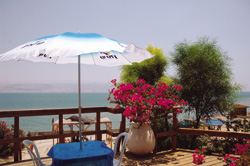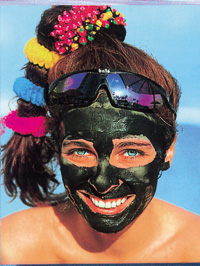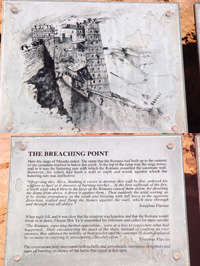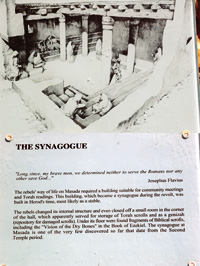 
|

|
Feeling Alive At The Dead Sea
A dip in the blue waters cleans, clears, beautifies and rejuvenates-both body and soul. The rich minerals do work, finds Farzana Contractor
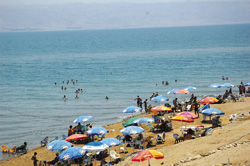 |
| Tourists throng the Dead Sea. |
After walking around the ruins of Masada in the sweltering heat, driving down to the Dead Sea a few minutes away and taking a dip in it offers great respite. This even though the water stings terribly if you have even the smallest of scratch on your body. For someone like me who chews her nails, my fingertips were on fire.
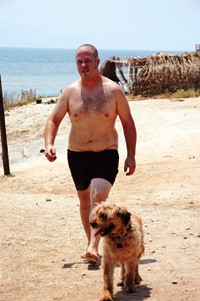 |
| My dog loves the sea too! |
The Dead Sea, the world�s lowest point at over 400 metres below sea level, 65 kms in length and 18 kms across its widest point, is a major attraction for international visitors. It is well-known for its high density, which makes it impossible for bathers to sink. The Dead Sea, fed mainly by the Jordan river supplemented by smaller rivers, underground springs and floods, is not really dead. Though no fish survive in it, it actually has 11 species of bacteria that manage to do so, in addition to its rich deposits of minerals. These minerals with a little bit of help from the climate provide various health-giving properties.
 |
| Not sinking in the Dead Sea. |
The Dead Sea�s unique qualities go back at least to the 4th century BC when bitumen was swept off the surface by special boats and sold to the Egyptians who used it for embalming. Besides, the beauty secrets of Cleopatra were also associated with mud from the Dead Sea. Even Aristotle mentions the sea�s physical properties.
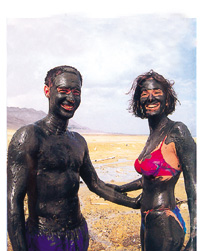 |
| The therapeutic mud is what everyone wants. |
In recent times the region has been developed as a health resort with a number of spas, clinics and hotels. At any given time there are innumerable people thronging this place. Happy vacationers go swimming into the water. Well actually, swimming is not the right word. For what you are supposed to do is gently, (for if the salty water gets in your eye you are temporarily blinded) as gently as possible walk into the water and without splashing any, sit on its edge. Then slowly reach for the floor, gather fistfuls of black mud and plaster it all over your body, face included. What this does is make you the most beautiful person instantly! Just joking. But yes, there are therapeutic values attached. A lot of people come here believing that their ailments, predominantly skin troubles, get taken care of. Compared to regular sea water, the water of the Dead Sea contains 20 times as much bromine, 50 times as much magnesium and ten times as much iodine. Bromine, a component of many sedatives, relaxes the nerves, magnesium counteracts skin allergies and clears the bronchial passages while iodine has a beneficial effect on certain glandular functions. Besides, various cosmetic companies produce ranges based on Dead Sea products because of their reputation for health and beauty rejuvenation.
The hot sulphur springs and mud deposits provide treatment for a variety of ailments. The heat, the concentration of salts on the skin and the enforced relaxation are all helpful particularly for muscular and joint conditions such as rheumatism and arthritis, fractures, several skin diseases and for those who simply want to unwind and be indulged. But there are those who find that the Dead Sea makes them ill rather than healthy. The hot sulphur springs can be dangerous to those with blood pressure problems and for certain treatments a medical examination is necessary.
The Dead Sea water does have a few qualities that are not too appealing. First advice - don�t shave just before bathing here, or expose any cuts or grazes to the water. It�s killing. The high salt content lets you know about tiny scratches you never knew you had. Whatever you do, don�t swallow any water for the magnesium chloride gives the water a revolting bitter taste. The calcium chloride makes the water feel smooth and oily to the touch and if your hair gets wet, it becomes both smelly and sticky. In addition after you come out of the water you find a residue sticks to your body which is a bit unpleasant. One doesn�t stay in the water too long, perhaps 10 or 15 minutes is sufficient. The fear of water getting into your eyes and mouth is pretty worrying, besides the sun bears down heavily on you.
Masada on the Dead Sea
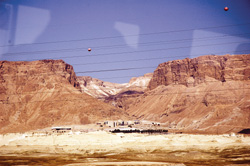 |
| The awesome Masada. |
Before taking a dip in the Sea, I had driven miles and miles, going past the Dead Sea to the base of the Masada fortress. I have to confess I knew nothing about Masada, except that it was a fort standing atop a huge rock.
Once there and history heard I was completely overawed. My guide was a sentimental sort of a person and the fire he put into his renderings only helped trigger emotions lying deep in my bosom.
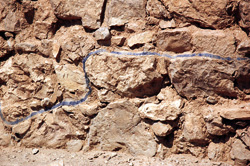 |
| Below the blue line: the old; above: the new. |
I can�t bear any kind of injustice, or pain and sacrifice and when suicide is undertaken on a mass scale it�s all the more traumatizing, even if it happened in A.D. 74.
As it is the unbearable hot sun was searing my skin and Masada�s history only scorched my soul further. Power can drive people insane! The Romans were no better. Masada is best known as the place where 960 Jewish fighters took refuge after the fall of Jerusalem, only to commit mass suicide. When they realized the Roman Tenth Legion would finally break through their defences, they chose to die as �free people� rather than be enslaved.
The story of the siege of Masada (as described by a contemporary historian Josephus Flavius) goes like this: Following the destruction of the Temple in Jerusalem in 70 AD, a remnant of Jewish rebels took over the Herodian fortress and withstood the Roman siege. The end came only when the Roman commander Flavius Silva, had an enormous access ramp constructed on the west side of the mountain, enabling his army to reach the fortifications. On the eve of the final Roman attack, one of the most moving tragedies in the history of mankind took place within the walls. For fear of Roman retaliation and dreading above all the idea of slavery of the members of their families, the combatants of Masada chose to kill themselves and their wives and children rather than be taken alive by the enemy. They effected their plan by each member killing the rest of his family and finally the ten survivors drew lots choosing one who would kill the nine others and finally himself. At the end after the nine bared their throats to their companion and the sad was deed done, the sole survivor first looked around to see if in that slaughter there was anyone who needed him. Only when he was certain they were all dead, he set fire to the palace where all the belongings had been earlier piled and then plunged his sword into his body and fell. With him fell the last bulwark of the Jewish revolt. When the Romans managed to get through the smoking ruins they found nothing but a lifeless Masada.
For years the young Israeli state used Masada as the site to swear in their soldiers. After finishing basic training, they would climb the crest of Masada at dawn and take a solemn oath, �We shall remain free men; Masada shall not fall again.�
A large archaeological international expedition, led by Professor Yigal Yadin uncovered over 90 per cent of the site between 1963 and 1965. Not only the ancient fortress but also numerous buildings, palaces, storerooms and water facilities were excavated. In the course of the explorations the excavation team also discovered a synagogue which the Jewish rebels had built after they seized Masada in AD 66.
The rock-fortress of Masada rises about 1400 feet from the western shore of the Dead Sea, the lowest point on the earth. Steep cliffs frame the four sides of this natural plateau. It was initially built by King Herod the Great. He built a great deal in Israel and a lot of his buildings still stand strong and majestic. Thus it was also in Masada. This megalomaniac king conjured an image and even the desert around the Dead Sea became a playground for him. In the middle of the Biblical landscape on a steep rock, he built his holiday resort, where he would go to relax, enjoying the healthy Dead Sea minerals. Later during his rise to power though Herod kept his family in the safety of Masada, he would never have expected that his luxury spa would one day become Israel�s most celebrated site by Zionists.
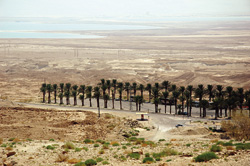 |
| Overlooking the Dead Sea. |
In the west lies the remains of the Western Palace, which has a mosaic floor in a geometric pattern. Further down is the swimming pool and then comes the most famous palace on the northern tip. Which, like the gardens of Babylon, it balances three steep terraces down the rock. There are some beautiful marble columns and frescoes still left from the original structure. The terraces give a view of the Dead Sea and the desert.
But the most fascinating aspect on Masada was its water supply. They captured rain water as it ran off the mountain and guided it into storage areas called cisterns. It does prove that the human mind works best and can achieve what it wants to in times of necessity.
Today, Masada has been turned into a national park. A cable car has been built on the eastern side to take hundreds of people upto Masada each day. School children, foreign students mingle as they walk through the restored ruins.
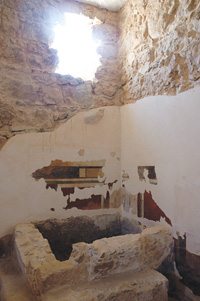 |
| The royal bath with its original paintings. |
One can see the remains of Herod�s lavish steam room and elegant oval swimming pool which drew water from the cisterns. There are two restored mikveh or ritual baths that the Jewish rebels built to fulfill Jewish purity laws. In addition you also the remains of the rebels� personal belongings that were not burnt - including garments, leather goods, baskets and housewares.
Standing on the edge of the cliff, looking out at the Dead Sea one can�t help but think that Masada will always remain a symbol of the heroic life and struggle of the Jewish zealots.
PHOTOGRAPHS BY FARZANA CONTRACTOR
|
|
|

Home Page
About the mag
Subscribe
Advertise
Contact Us

|





